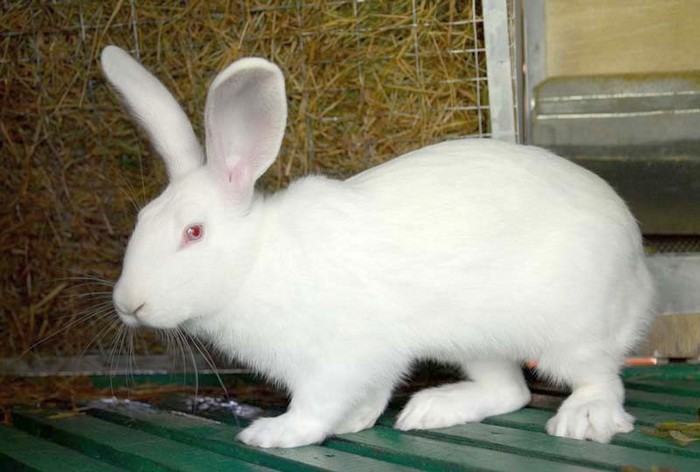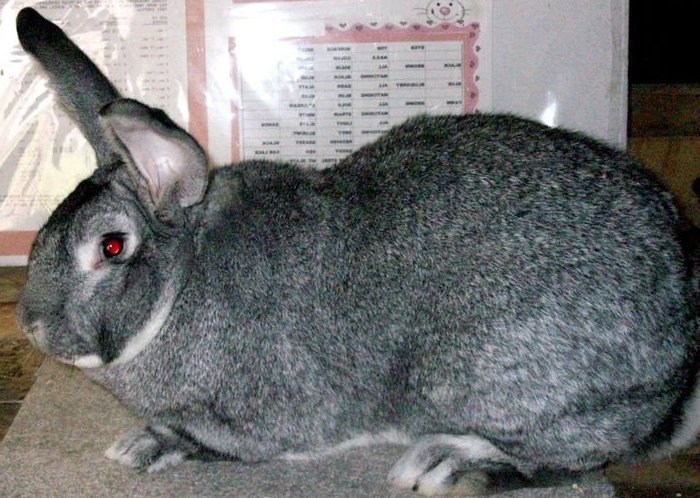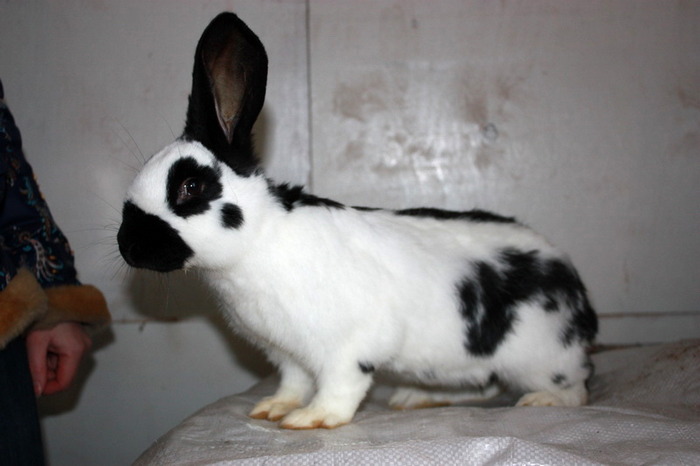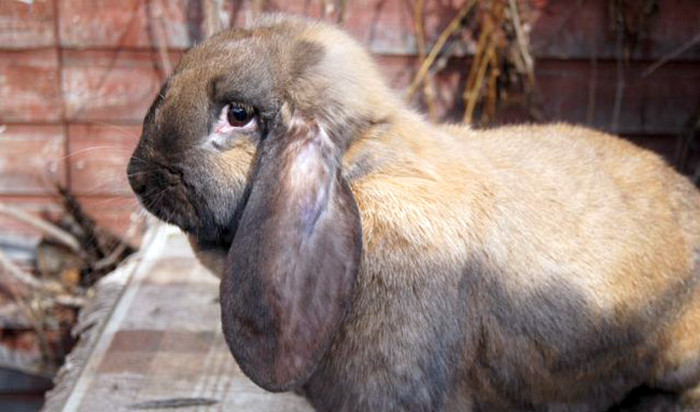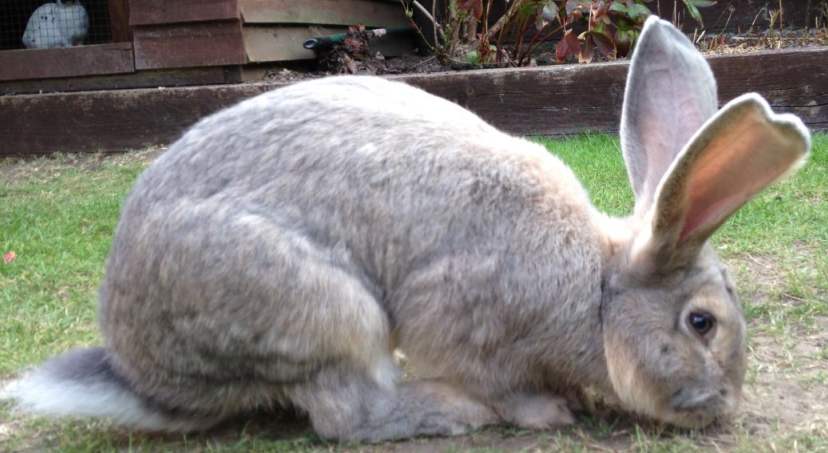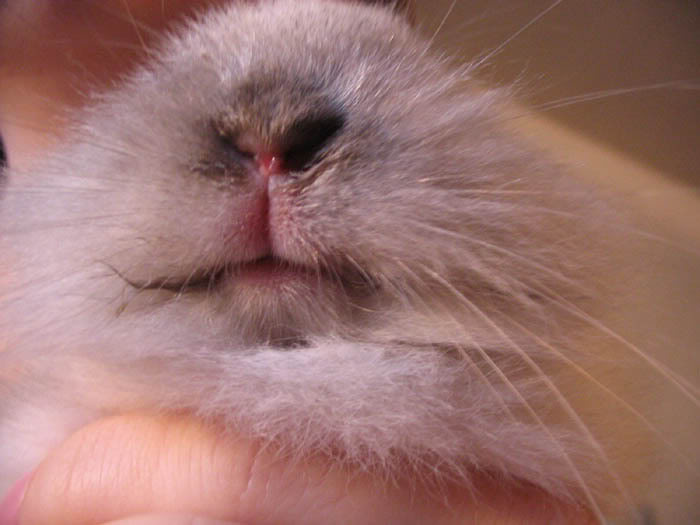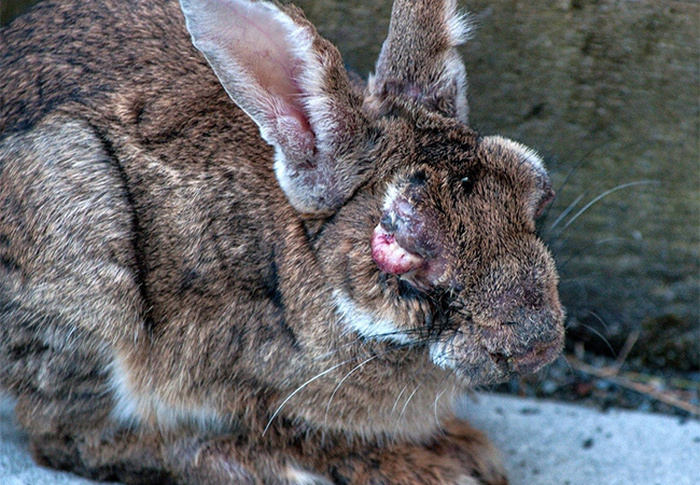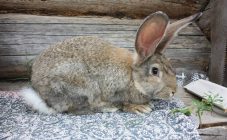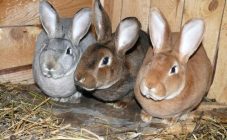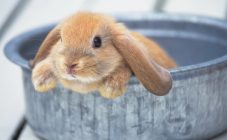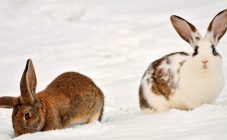Content:
Rabbit breeders have bred a lot of different breeds: from miniature representatives to giant rabbits. Each representative has its own advantages. Giants are famous for their large physique, heavy weight and high productivity. Giant rabbit are superior to giant breeds.
What breeds are giants
Rabbits are giants are represented by the following breeds:
- White giant.
- Gray giant.
- Belgian giant or Flanders.
- German spotted giant.
- Lop-eared ram.
- Conti or continental giant.
Features and characteristics of rocks
White giant
These rabbits were bred by crossing Belgian albino rabbits in the 19th century. The breed is characterized by a strong physique, snow-white coat color, thick fur and red eyes. Body length reaches 55 - 65 cm, weight - 5.3 kg. Rabbit feet are strong despite their sophistication. Erect ears are medium in length. Most often they are bred to obtain a snow-white skin that dyes well. Also, white giants are used for crossing and obtaining new large breeds of rabbits.
Gray giant
It was bred in 1952 in the Poltava region by crossing the Flanders with common Russian rabbits. The coat of this breed is gray, but there are representatives with black and white colors, which also belong to giants. The rabbit grows up to 65 cm and gains weight up to 6.5 kg. The ears are straight and erect, with a slight rounding at the ends. The breed has a high resistance to low temperatures and most diseases. Rabbits are unpretentious in keeping conditions.
Belgian giant, or flandre
It is considered the most popular representative among giants. Sometimes these rabbits are classified as giant breeds. On the basis of the Belgians, most of the large breeds were bred. The body is quite large and elongated, the mass can reach 12 kg. Rabbits have short front legs and long hind legs. The head is large, the ears reach 19 cm. A straight and wide area of the spine and a strong skeleton are characteristic. These rabbits have a long tail with good stiffness, raised. Among the most popular colors:
- Blue.
- White.
- Grey.
- Coffee.
- The black.
- Kangaroo.
The breed is famous for its high meat production. Flanders have long, 18 cm ears. The disadvantages include the late start of reproduction. Despite this, the females bring a large number of rabbits.
German spotted giant
The German giant rabbit (another name for the breed is the strokach rabbit or the German butterfly) was obtained by crossing a flandra with a black and white rabbit. Officially, the breed of German variegated giant was registered in 1907. Breeders continued to work on crossing German butterflies, and in 1937 they received the Riesen breed.
Rabbit stokach - breed description:
- Individuals have well-developed muscles and strong legs.
- The body length reaches 71 cm, and the ears - 18 cm.
- The average weight of a rabbit is 6 kg.But there are representatives reaching 10 kg.
- Big brown eyes.
- Rabbits have soft fur with a slight sheen, 3.5 cm long.
- Black spots on the white body are located symmetrically on the back and sides.
The fur color of strokach rabbits in one litter may be different. There are piebald, snow-white, monochromatic. White with black spots is considered standard. To obtain this shade of wool, a standard rabbit and a snow-white rabbit are used.
To keep such rabbits, open-air cages without a mesh floor or large cages are used. Rabbits do not tolerate drafts, dirty enclosures, darkness and direct sunlight. Sexual maturity occurs at 6 months. You can get up to 20 baby rabbits in one litter.
Lop-eared ram
The breed was bred by English rabbit breeders. It is characterized by a large physique, a massive head, long drooping ears, and a humped nose. Rabbit breeders distinguish several types of sheep:
- german,
- English,
- French,
- Dutch,
- dwarf,
- fleecy,
- Meissen,
- plush.
The German and French ram have almost the same characteristics. The English species has large ears and short legs. A fleecy specimen has a long fluffy coat, and a teddy one has a short one. The smallest representatives of the breed are Dutch and dwarf rabbits.
The weight of an adult can vary from 8 to 10 kg. The ram has an average fertility rate: in one litter, the female brings up to 7 babies.
The ram has a calm and friendly character. Good for keeping as a pet. Aviaries are suitable for keeping, since the rabbit is large.
Continental giant
Two representatives of this breed were included in the Book of Records.
The average weight of a konti rabbit is 16 kg. With proper nutrition and care, they can gain up to 20 kg. Body length reaches 65 cm. Conti have long 20-centimeter ears, high-density and powerful bones, thick fur.
Rabbit fur, reminiscent of silk, is available in several colors:
- Agouti. The fur has a chestnut shade with an orange center and dark gray undercoat. The rabbit's belly is white. Ears and tail have black piping.
- Red agouti. Chestnut red coat with dark ticks and blue undercoat. A creamy shade prevails on the belly and tail.
- Deer characterized by reddish tones, light undercoat, and beige belly.
- Opal the shade consists of a pale blue tint at the tips of the coat, a creamy middle and a dark undercoat. There is a blue piping on the ears. Belly and tail are light beige.
- Light steel has a gray hair end, a sandy middle and a gray-blue base.
- Dark a dark gray shade is inherent, which lightens closer to the skin.
- The black the fur has a uniform shade. The color of the eyes of these rabbits is brown or black.
The long life of the conti is 5 years. They have a docile calm nature.
Diseases of giant rabbits and how to treat them
Infectious stomatitis
The disease is viral. Infection occurs from one animal to another. Characterized by lesions in the oral cavity, rabbit lethargy, decreased appetite. Depletion of the body leads to death. Young individuals aged 20-25 days are most at risk of infection. When symptoms of the disease appear, sick individuals are deposited, and the cells are disinfected.
Treatment for infectious stomatitis consists in treating the animal's oral cavity. To do this, use:
- Potassium permanganate in the form of a 0.15% solution.
- Copper sulfate (2% solution).
- Streptocide powder 1 time 0.2 g for several days.
- Penicillin injections given subcutaneously.
Myxomatosis
The carriers of the virus can be bloodsucking, birds, sick individuals. At the beginning of the disease, signs of conjunctivitis and rhinitis appear, then tumors appear on the body. This disease does not provide for treatment, so sick rabbits are allowed to slaughter, the cages and feeders are thoroughly disinfected. For prevention, the livestock is vaccinated.
Rabbit Viral Hemorrhagic Disease (VHDD)
This disease is characterized by the following symptoms:
- Increase in body temperature up to 41 degrees.
- Weakness, lethargy.
- Loss of appetite.
- Diarrhea.
- Pneumonia.
- Blue lips.
As well as myxomatosis, HBV cannot be treated. To protect the livestock from death, timely vaccination is carried out.
Feeding
To get good skin and high quality meat, it is necessary to correctly formulate the diet of rabbits. Among the rough food, rabbits need millet, rye, legumes, corn and oats. Also, be sure to include green foods, seasonal fruits, vegetables and herbs.
In autumn and winter, vitamins and minerals are added to the diet. In winter, rabbits must be fed with hay, straw, tree bark (coniferous and deciduous).
Breeding giant rabbits
When breeding rabbits of giants, it should be borne in mind that they reach sexual maturity at 6 - 7 months. Females are highly fertile. On average, about 7 baby rabbits can be obtained for one okrol. Unlike small breeds, female giants have a less developed maternal instinct. This is manifested in the inability to equip the nest for babies and skipping feeding the rabbits. Despite this, the rabbit has a sufficient supply of milk to feed the offspring. Rabbits are planted at the age of 1.5 months. At the same time, the female can be prepared for a new mating.
To raise good offspring, the breeder needs to monitor the pregnant female, help her to equip the nest in the uterine compartment and put the babies in for feeding.
Rabbits of the giant breed are represented by a wide variety of species. Some of them are bred for high quality hides, others are used for meat production. Unpretentious rabbits are giants in breeding, growing and feeding. Therefore, breeding them is considered a lucrative business idea.
